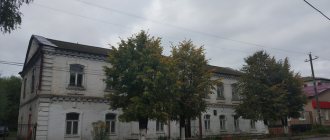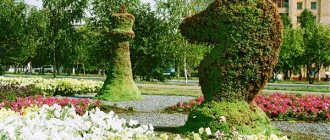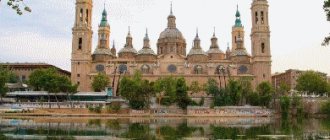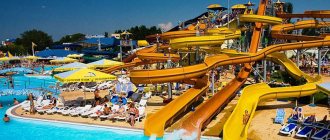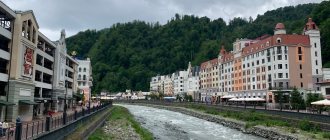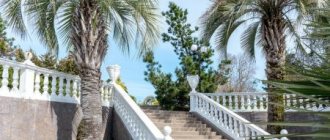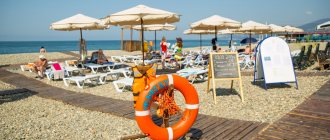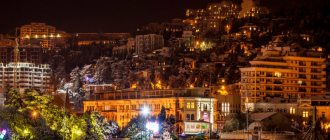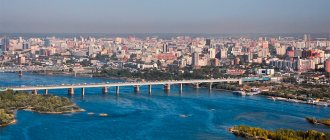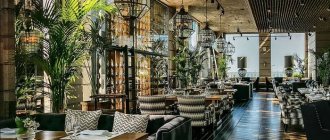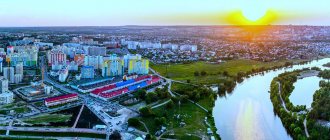What does the Our Ural website know about Chelyabinsk? In the section of the site “Attractions of the Urals, notable places of the Urals: Chelyabinsk region” there are only two articles: “Kirovka (Chelyabinsk Arbat)” and “Chelyabinsk Museum of Local Lore”. In addition, in the competition “To the Holy Places of the Urals” Sonya Shishkina spoke in detail about the temples of the city. However, in the center of the city there is an unusual monument to Lenin, and the “Sphere of Love”, and Pushkin Park, and the Stalin Empire style, and the South Ural University... Despite our short stay in Chelyabinsk in 2012, we have something to tell about them, yes and about the city as a whole.
WHY GO?
Chelyabinsk has a reputation as an industrial giant. At least half of its area is occupied by giant industrial zones. The city is famous for its monster factories: ChMZ, ChTZ, ChTPZ. If we switch to Russian, these are various plants: metallurgical, electrometallurgical, tractor, pipe-rolling, coke-chemical, zinc-electrolyte and others. Photos of the city on the Internet show smoking chimneys.
Recently, the city and its residents have become a household name thanks to milling machine operator Ivan Dulin and the corresponding episodes of “Our Russia.” “Chelyabinsk men are so harsh that they don’t drink coffee, but eat it from a jar with a spoon.” “Chelyabinsk men are so harsh that they put a knife on their bread.” “Chelyabinsk men are so harsh that they don’t milk the cow, but squeeze it whole.”
And not so long ago, a film from Leonid Kanevsky’s series “The Investigation was Conducted” was shown on TV. Bandits in Chelyabinsk, working under the guise of taxi drivers, killed passengers on the way from the airport. They didn’t immediately realize that the newcomers were missing – the gang had 15 murders to its name. It is not surprising that tourists do not go to Chelyabinsk. However, it is strange to consider yourself a traveler in Russia without having visited all its million-dollar cities at least once. Heading into the city, my wife and I were sure that in a metropolis of this size we would definitely find something interesting.
Project on the topic “My hometown is Chelyabinsk” for 2nd grade
Goal of the project: As part of studying the subject “The World Around You,” talk about your hometown, its attractions and memorable places.
Find information about his story and share it with your classmates. Tell schoolchildren about Chelyabinsk and why I love it. Prepare a report and presentation in the form of a photo story. Project plan:
- Location on the country map.
- History and symbols.
- Chelyabinsk in the present.
- Attractions.
- Places of military glory.
- Conclusion.
- An example of a finished photo story-presentation.
SHORT STORY
Chelyabinsk was founded as a fortress in 1736 and was part of the Orenburg province. In the 19th century, it was a quiet county town with a sluggish economic and cultural life. A revolution in development took place at the end of the 19th century in connection with the construction of the Siberian Railway from Samara to Omsk via Ufa-Zlatoust-Chelyabinsk. The city had the honor of becoming the “gateway to Siberia,” and by the beginning of the 20th century it became the largest trade and intermediary center in Russia. During the period of industrialization, the largest industrial enterprises, famous throughout the country, were built here. Suffice it to name the Chelyabinsk Tractor Plant, which produced tanks for the Soviet Army during the Great Patriotic War. From a letter to Stalin from Kuzma Ryndin, first secretary of the Chelyabinsk regional committee and city committee:
"Chelyabinsk" translated into Russian means "pit". Therefore, often in conversations the word “chelyaba” is used as something negative, backward. The name of the city has long been outdated, it does not correspond to its internal content... Therefore, we ask you to allow us to rename the city of Chelyabinsk to the city of Kaganovichgrad.”
However, Stalin wrote “Against” on this letter. The first secretary was shot two years later - however, not for this at all. The city was actively growing; its millionth resident appeared in 1976. According to the 2010 census, the city ranked ninth in population in Russia.
Presentation “Walks around your beloved Chelyabinsk”
#9th grade #10th grade #11th grade #Local history #School education #Project activity #Presentation
Walks around your beloved CHELYABINSK Prepared by student 11 "A" class MBOU "Boarding School No. 10 of Chelyabinsk" Tulubaeva Arina
The city of Chelyabinsk was founded on September 13, 1736.
The city's coat of arms depicts a camel.
There are seven districts in our city.
Sovetsky district
Sovetsky district One of the administrative districts of the city of Chelyabinsk. Formed on September 10, 1937. The area of the district is 113.3 square kilometers. Population: 134.3 thousand people. On the territory of the district there are 30 large industrial enterprises, a railway station, a city garden named after A.S. Pushkin, several large cultural institutions “Chelyabinsk State Academic Drama Theater named after Naum Orlov”, Chelyabinsk State Theater of Young Spectators, municipal cultural institution “Chelyabinsk. There are many historical monuments in the Sovetsky district.
City Garden named after A.S. Pushkin Cinema named after A.S. Pushkin Shopping complex "Sinegorye" Steam locomotive "Kommunar" City Academic Drama Theater named after Naum Orlov Memorial complex of grieving mothers "Memory"
Revolution square
Revolution Square The city center is Revolution Square. Several streets converge on the square: Zwillinga, Kirov, Vorovskogo. Lenin Avenue, the main street of the city, runs through the square. The square is a large open space where rallies and parades are held. On the square there is a square with a large fountain and a monument to Vladimir Ilyich Lenin. Under the square there is trade in the Nikitinsky Rows shopping complex.
Train Station
Railway station Chelyabinsk-Glavny Station is a junction station on the Trans-Siberian Railway. From here trains run northwest to St. Petersburg, east to Novosibirsk and Vladivostok, south to Astana, and west to Moscow. There are 2 pedestrian and 1 automobile bridge over the station tracks, connecting the Sovetsky and Leninsky districts of the city. Chelyabinsk railway station is a modern complex that offers passengers a wide variety of services. Our station looks like a “ship”. The hotel building is “Mast and Sail”, two floors of the main building are “Two glazed decks”. The station building houses a winter garden with exotic plants, a stone museum, three fountains, a gallery of engravings depicting the railway and stained glass windows, which have become the hallmarks of the railway gates of the Southern Urals.
Quiz Question???
Where is the monument located? The monument is located on Revolution Square.
central District
The central district is one of the oldest districts of the city. The central district is one of the oldest districts of the city. The population of the Central District is 87 thousand people, the total area of the district is 64 square kilometers. Currently occupies the central and western part of the city. It is washed by the Shershnevsky Reservoir and the Miass River. The district includes the Gagarin Culture and Leisure Park and the Shershnevsky Forest Park, pedestrian Kirova Street, Aloe Pole Park, and the zoo—favorite vacation spots for city residents. central District
“Sphere of Love” Scarlet Field South Ural State University Park named after Yu. Gagarin Opera and Ballet Theater
PKiO named after Yu. Gagarin
Formed in 1936 in the forest park area of Chelyabinsk. The park is a place of recreation for citizens, an excellent place for walking and playing sports. Citywide holidays and sports competitions, concerts, and regional folk art festivals are held here. The park has a five-kilometer-long children's railway, a fountain on the central alley, a paintball court, and go-karting. On the territory adjacent to the park there are: the city “Zoo”; “Ural Lightning” – indoor skating ice palace; South Ural State University. About one million people visit the park annually; on weekends and holidays in the summer, about thirty-five thousand visitors are in the park at a time. PKiO named after Yu. Gagarin
Zoo Karting Paintball Ice Palace
Arbat
Arbat One of the most popular attractions in Chelyabinsk is Kirova Street. It is called “Chelyabinsk Arbat” - a pedestrian street in the center of Chelyabinsk. On Kirovka you can see houses built in the 19th and 20th centuries and life-size bronze figures. Here you can visit shops, restaurants and cafes. Sometimes musicians perform on Arbat. Several years ago, the Chelyabinsk City office high-rise skyscraper building was erected on Kirova Street.
Quiz Question???
What area did the guys talk about? C E T R A L N
Kalininsky district
Kalininsky district is one of the youngest districts of the city of Chelyabinsk. Kalininsky district is one of the youngest districts of the city of Chelyabinsk. The area of the region is 48 square kilometers, the population is 200 thousand people. The district was formed on December 9, 1970. Today it is the largest in terms of population. Kalininsky district
Temple New residential area Shopping center Chelyabinsk State University Emergency hospital
Circus
Circus This is a large building in the city center, on Kirov Street. The circus in Chelyabinsk was founded at the beginning of the 20th century. He went through civil wars, revolutions and the Great Patriotic War. The circus always delights its visitors with unforgettable performances of aerialists, tightrope walkers, fiery clowns, jugglers, jockeys, as well as trained animals. Quite often the circus arena is filled into an ice skating rink. At the entrance to the circus there are two sculptures: a bronze “Clown” and a copper “Equilibrist”. Every year, the circus hosts tours of many of the most famous circus performers, both in Russia and other countries of the world.
Puppet Theatre
Puppet Theater Chelyabinsk State Regional Puppet Theater, one of the oldest in Russia and the Urals. The building of the Puppet Theater is located on Kirov Street. The theater has a large repertoire of fairy tales that teach goodness and appeal to children. In this special theater, actors and puppets perform on stage together.
Quiz Task
Select attractions of the Kalininsky district Puppet Theater Station Gagarin Park
The metallurgical district was formed on February 22, 1946. The metallurgical district was formed on February 22, 1946. Population: 142 thousand people. The area of the district is 106 square kilometers. The metallurgical district is distinguished by its clear layout, “air corridors” enriched with greenery and flowers. Many street names are associated with historical ones, for example, streets named after the 60th anniversary of the October Revolution, named after the 50th anniversary of the Komsomol, First Sputnik. The central street is named after Bohdan Khmelnytsky. Metallurgical District
Cinema "Russia" Church of St. George the Victorious Palace of Culture ChMK Lutheran Church Central Club
Airport
Airport Metallurgical District is the city's air gateway: an international airport of federal significance is located here. It was formed in 1930 in the suburbs of Chelyabinsk and named “Balandino Airport”. In 2008, it was renamed “Chelyabinsk Airport”, the name the airport bears to this day. Equipped with one of the best runways in Russia, the airport has air connections with the largest cities of the Russian Federation, countries of the near and far abroad. Thus, a solid basis has been created for the development of multilateral relations between the Chelyabinsk region and various regions of the Russian Federation, as well as at the international level.
Kashtaksky pine forest
Kashtaksky Bor In the northwestern part of the district, the residential areas are adjacent to the Kashtaksky Bor, which is rightfully considered the decoration of the area. This is a natural monument of regional significance. Its area is 1543 hectares. It is located on the right high bank of the Miass River, where there are rocky outcrops of granite, including the famous Sokolinaya Mountain. The most common trees are pine, as well as birch and aspen. Recently, oak, maple, and poplar have been planted. Fauna: hare - hare, squirrel, gopher, mole, mouse-like rodents. The Miass River flows through the forest.
Quiz Game
Game “True-False” True The Lena River flows in the Kashtak forest. False False The airport is located in the Metallurgical District. Palm trees grow in the forest.
Traktorozavodsky district
It was created on January 10, 1937 and named after the main enterprise of the region - the Chelyabinsk Tractor Plant (ChTZ). The area of the district is 62.8 square kilometers. The population is 156 thousand people. On the territory of the district there are more than 20 enterprises of mechanical engineering, defense, light and food industries, the Ice Palace, the Yubileiny swimming pool, the Victory Garden, the children's park named after. V. Tereshkova. Traktorozavodsky district
Chelyabinsk Tractor Plant Komsomolskaya Square Palace of Culture Temple ChTZ Theater Shopping and entertainment complex "Gorki"
Victory Garden
The Victory Garden was founded in the early 1930s simultaneously with the construction of the ChTZ on the basis of a natural birch grove. The Victory Garden is the most patriotic of all the parks in Chelyabinsk. In the Traktorozavodsky district of the city, it occupies a large area - 19.5 hectares. More than twenty years ago, a monument to tank builders who died during the war was erected on the main site of the Victory Garden. Nearby are plaques with the names of those who did not return. And nearby stands the sculpture “Angel of Peace”, as a reminder to everyone that it is necessary to maintain good neighborly relations.
In the Victory Garden you can see many wartime cars. This is the only open-air museum of military equipment in the Urals. In one row there are tanks, ZiSs and other vehicles that helped win the war. Next to each machine its properties are written.
Quiz Question???
What is the name of the sculpture? The sculpture is called "Angel of Peace".
Kurchatovsky district
Kurchatovsky district The district was formed on August 15, 1985. The district received its name in honor of a fellow countryman - a world-famous scientist, organizer of domestic nuclear energy, Igor Vasilyevich Kurchatov. The area of the district is 5.5 thousand hectares. Population – 181.5 thousand people. The largest industrial enterprises of the city are located in the district: the Chelyabinsk zinc plant, a shoe factory, Khlebprom, and the Metran industrial group. The products manufactured by Kurchatov enterprises are famous for their quality and are known not only in the region and in Russia, but also abroad.
Cinema KinoMax-Pobeda Metran Ski resort CHVVAKUSH
Unichel
Unichel is a large enterprise for the development, production and sale of footwear. It was created in 1932. Unichel is one of the five largest shoe manufacturers in Russia. The enterprise is equipped with the latest technological equipment for the manufacture of shoes according to modern standards. The company's products are in demand among customers because they meet their requirements for quality and design.
CHVVAKUSH
CHVVAKUSH Chelyabinsk Higher Military Aviation Red Banner School of Navigators is one of the oldest educational institutions in the Russian Air Force, founded on October 1, 1936. During the Great Patriotic War, navigators fought the enemy for the honor, freedom and independence of the Motherland. Many of them were awarded orders and medals, and 30 of them were awarded the high title of Hero of the Soviet Union. In 2002, CHVVAKUSH was renamed the Chelyabinsk Military Aviation Institute of Navigators - the only educational institution of the Air Force that trains navigators.
Quiz Task
Sort out the attractions Metallurgical District Sovetsky District Kalininsky District
Leninsky district
Leninsky district The area of the Leninsky district is 75 square kilometers. The peculiarity of the area is that it was created as a military-industrial complex. The Leninsky district today remains the base for the development of the most important sectors of the Russian economy: mechanical engineering, ferrous metallurgy, energy, production of building materials, food and wood processing industries.
Palace of Culture ChelPipe Hotel "Smolino" Entertainment complex "Aurora" Alley Temple
Lake Smolino
Lake Smolino Lake Smolino is a natural slightly salted reservoir located in the Leninsky district of the city of Chelyabinsk. Lake Smolino is oval in shape and stretches from north to south for 6 kilometers. The maximum depth is 6 meters. The bottom is sandy and rocky. In the past, the water and mud of the lake were used to treat various diseases. The water in the lake is rich in nutrients, which makes it possible to use the lake for fish farming. Species such as ripus, carp, pike, and cheese were thrown into it.
Quiz Question???
Water in Lake Smolino: salty; fresh; lightly salted;
Thank you for your attention! Come visit us!
HOTEL
Although Chelyabinsk is an industrial city, it has two five-star hotels. By the way, according to the 2GIS company, the share of five-star hotels in the city is 4.6%, and according to this indicator it is the fifth in Russia. In Perm, for example, there are no 5-star hotels at all.
According to the same 2GIS, the most popular hotel names in Russia are “Uyut”, “Voyage”, “Victoria” and “Visit”. But we made a choice, like somewhere in Europe, between “Vidgof” and “Markstadt”. In the end, we chose a cheaper one and located closer to the local pedestrian street “Markstadt”. At the time of selection, this hotel had the highest rating among hotels in the city on the website komandirovka.ru.
There are different ways to get to the city. The well-known head of the workshop, and now the presidential envoy Kholmansky, surprises the townspeople by flying from Yekaterinburg to Chelyabinsk by plane. We got there by train Ekaterinburg-Orenburg. When we arrived, it was already dark. “We won’t take a taxi in this city,” said the wife. We took a minibus and soon got off at the Aloe Pole stop, from which we walked to the hotel. The Markstadt Hotel was opened in 2009 and has 92 rooms. At the accommodation desk there was an insignia received in August of this year from the famous review site TripAdvisor. We were not required to pay upon check-in. The standard room on the second floor suited us quite well. The window faced the courtyard, we did not hear any noise. The room had an LCD TV, bathrobes, slippers, hairdryer, safe, telephone, and there was a cooler with drinking water nearby on the floor. Everything is new, everything worked, no comments.
Chelyabinsk State Puppet Theater named after. V. Volkhovsky
Chelyabinsk State Regional Puppet Theater named after V...
Chelyabinsk
The Chelyabinsk Puppet Theater is one of the oldest in Russia. Its story began with the doll Parsley - with it, dramatic actors Pavel and Nina Garyanov came to Chelyabinsk in the early 30s of the 20th century. Six years later, the country's first studio opened here, where actors and puppeteers were trained.
In the 70s and 80s, the main director of the theater was Valery Volkhovsky, then the era of unscreened performances began - the actor and the puppet became partners on stage. The outstanding puppeteer director is still called the father of the Chelyabinsk puppet theater - in 2006 the theater was named after Volkhovsky.
SCARLET FIELD
We devoted the next day to getting to know the city center, moving only on foot. Leaving the hotel, we turned left and immediately came to the Aloe Pole park, filled with evidence of the Soviet past. Our attention was drawn to the memorial to pioneer heroes, opened in 1986 for the 250th anniversary of Chelyabinsk. 12 bronze portraits are placed on the front sides of 12 pedestals lined with granite. We saw so many pioneers - heroes at once for the first time in our lives. Well, just like the 12 apostles! The well-known Pavlik Morozov was here, as well as Volodya Dubinin and Lenya Golikov, whom we knew from our pioneer childhood. However, we learned about most of the characters for the first time. For example, Marx Krotov. Not Max Krotov, but Marx! The residents probably do not hold this memorial in high esteem; from time to time they draw something on the sculptures or break off parts of them. During the perestroika years, the Aloe Field was a place of rallies. Today, too, people stood here with posters saying “President Putin, stop the corruption and lawlessness of the authorities of the Chelyabinsk region!”
Further in the park we came across a strange structure - Lenin’s head, hidden deep in the grotto. Construction of this mausoleum began in 1924 immediately after the death of the leader. This was the initiative of the Muslim population of Chelyabinsk, and they built with their own money and according to their own architectural design. The result was a unique “architectural homemade” of its kind. Either a mosque, or an Egyptian obelisk, or a tribune, or a Moorish pavilion. Surprisingly, he has survived to this day. Ilyich from the 1920s looks unusual. He is depicted with some kind of suffering on his face, having not yet acquired the required monumentality. An iron door caught our attention. This is clearly not the entrance to the tomb, then why is it there? Maybe there's a library there? Alas, as we were told, brooms and shovels are stored there.
Nearby was the former Alexander Nevsky Church with the sign “Hall of Chamber and Organ Music”. It was built according to the design of the famous Moscow architect Alexander Pomerantsev in 1916. In 1922, valuables were confiscated from the temple, with the proceeds from the sale of which the Bolsheviks planned to fight famine. In 1930, during the anti-religious campaign, the temple was closed, crosses, domes, and the bell tower tent were removed from the building. Later there was a printing house, a regional art gallery, a planetarium, and clubs at the Palace of Pioneers. The chamber and organ music hall opened there in 1986, also on the occasion of the 250th anniversary of the city. One of the best concert organs in Europe was installed here - a German instrument.
Here is what Chelyabinsk resident vedmed1969 writes about recent history: “In the early 1990s, there was a real war around the building regarding the return of the church. The Orthodox walked around in religious processions, held prayer services, and at the same time complained to Moscow, reached out to Rutsky, he ordered the building to be returned to the church, the organ to be moved somewhere - that is, simply thrown out, since it was made for the acoustics of a particular building. But then the White House was shot, and Rutskoi’s signature lost its validity. However, they managed to put up crosses.” Nevertheless, in 2010 the building was returned to the diocese. The organ is still functioning, but at the same time Orthodox services are held here.
SPHERE OF LOVE
After walking through Aloe Pole Park, we walked along Krasnaya Street, crossed Lenin Avenue and turned onto Sonya Krivoy Street. Not Sophia, but Crooked Sonya - well, just like in Odessa, only this Sonya is not a raider, but a revolutionary. Here is the Kinomax cinema, and next to it is the composition “Sphere of Love”. It was Monday, there were no brides and grooms nearby, and we could take a close look at her. It is a huge blue glass dome supported by four trees. Under the dome there are figures of a young man and a girl flying towards each other. The composition serves as a must-have place for wedding photo shoots. It has three stairs. The bride and groom go up each in their own way, dance a wedding dance on the landing, and then go down the middle staircase together.
I'll give you a few numbers. It took 12 tons of copper to make the metal trees, which are 8.5 to 9 meters high. The height of the composition is 12 meters, the diameter of the dome is 10 meters, the size of the figures of a young man and a girl is 4 meters. The dome and copper parts of the composition were made in Italy. The composition was installed in 2000; a group of sculptors led by Viktor Mitroshin worked on its creation. The composition is quite unusual; we have not seen anything like it in Russian cities. One can only be happy for Chelyabinsk brides getting married in such a romantic setting. We took pictures and remembered our wedding. It was so long ago!
PUSHKIN PARK
From Kinomax along Timiryazev Street we went to the main square of the city - Revolution Square. Our attention was drawn to a round building standing on a hill. It closed the huge square and seemed to float above it; a solemn staircase led to it. It turned out to be the Naum Orlov Drama Theater. The building was built according to the design of Chelyabinsk architects in 1982 and bears the unofficial name “drum”. At the opening, the main entrance was decorated with Kasli cast iron - sculptures of Russian and Soviet writers, theater figures, and scenes from plays. The idea is interesting, but we were not able to fully evaluate its implementation. Thirty years later, only two of the six monuments survived; only pedestals protruded from the rest. Many bas-reliefs were also broken.
Right behind the theater we found the entrance to a small park. It bears the name of Pushkin, and was decorated accordingly - a bust of the poet, a small monument, a lady of Pushkin’s time near the rotunda. Perhaps this is Tatyana, or maybe Natalya Nikolaevna. True, it turned out that the poems cast nearby in bronze did not belong to Alexander Sergeevich at all, but to a certain Asya Gorskaya!
Favorite park for secrets and dates
Keeps the words of Onegin's confessions.
Let's sit down on the bench of memories.
We actually sat down on the bench next to Tatyana. The red steam locomotive located in the corner of the park, repaired in the 1920s during a community cleanup, reminded of the revolutionary years, and the art object “A Kiss to Chelyabinsk,” also bright red, reminded of modern times. Next to the art object there was a sign with a list of 12 sponsors and an indication of its beneficial properties: “The monument brings family happiness and boundless love.”
Chelyabinsk Museum of Fine Arts (art gallery)
Chelyabinsk Museum of Fine Arts (Picture…
Chelyabinsk
The Chelyabinsk Museum of Fine Arts is the only classical art museum in the Southern Urals. Its history began in 1940, when a city art gallery was opened in the Alexander Nevsky Church. Today the exhibition is located on two museum sites - in the building of the former Yakushev Brothers trading house and in a house on Revolution Square.
The museum collection includes rare examples of icon painting from the 16th to 19th centuries, handwritten and early printed books. The collection of Ural art includes works by Chelyabinsk painters and graphic artists, Kusinsky and Kasli iron casting masters. The pride of the museum is masterpieces of world art, among them works by Ivan Shishkin, Ivan Aivazovsky, Isaac Levitan, Ivan Kramskoy and Dmitry Levitsky.
STALIN'S EMPIRE
After passing Pushkin Park, we went out onto Zwillinga Street. Soon we discovered a bust of this character - a revolutionary, somewhat similar to Mayakovsky. Previously, the local drama theater also bore his name, but it was renamed, but the street name remained. It must be said that it is in Chelyabinsk that the interesting architecture of Stalin’s time has been preserved. In this, the city even surpasses its northern neighbor and rival, Yekaterinburg. Most likely, this is due to the fact that after the war the city was not only one of the most important industrial centers of the USSR, but actually the second. Although the nuclear production facilities themselves were concentrated to the north, in Snezhinsk, there were also many industries, specialists and scientists working on this project. Therefore, the state allocated enough funds for the construction of monumental buildings and residential complexes in the city center. It turned out to be a real reserve of the Stalinist Empire style, like in Minsk or Volgograd.
Even the arbitration court, unlike its colleagues from other cities who lined up tasteless plastic boxes, occupied a pleasant former hotel building (1934). The children on the facade of one of the houses somehow reminded us of pre-revolutionary angels. By the way, there are advertisements on house number signs in the city center.
At the intersection of Zwilling Street and Lenin Avenue is Revolution Square - one of the most beautiful Stalinist squares we have seen. Of course, the main city Lenin stands here. Walking along it past a long Stalinist house, we saw a gate with the city's coat of arms, indicating the beginning of a pedestrian street.
Natural attractions of Chelyabinsk
Scarlet field
Scarlet field
A park laid out in the 60s of the 20th century. According to historians, at the beginning of the 20th century there was a Fair Square, which was nicknamed the “Scarlet Field” after the dispersal of a peaceful demonstration. Now it is a well-kept park complex with sports and children's playgrounds.
Tourists should see the monument to Eaglet near the South Entrance, the monument to Lenin in the form of a two-story mausoleum and the Church of Alexander Nevsky.
Address: Chelyabinsk, Chelyabinsk region
Lake Smolino
Lake Smolino
Located in the southern part of the city. The estimated age of the reservoir is 4 million years; apparently, it was once a sea. At the beginning of the 20th century, the water in the lake was salty and rich in minerals. But now it is becoming increasingly desalinated - wastewater is discharged here.
There are a couple of beaches on the western shore of the lake. The most popular and well-maintained is Sunny Beach. In addition to a beach holiday, you can do some good fishing on the lake.
Address: Chelyabinsk
Victory Garden
Victory Garden
Not far from the First Lake there is a Victory Garden park. This spacious park has existed since the 30s of the 20th century. Then its name was “ChTZ Park” (Chelyabinsk Tractor Plant). In 1965 it was renamed Victory Garden. At that time, the green zone was quite neglected, with a minimum of infrastructure.
Soon the park underwent reconstruction: Alleys of Veterans and Peace were created, and children's playgrounds were installed. A significant part is occupied by the Museum of Military Equipment.
Address: Geroev Tankograda street, 75, Chelyabinsk, Chelyabinsk region
City Garden named after. A.S. Pushkin
City Garden named after. A.S. Pushkin
In the center of Chelyabinsk there is a huge (20 hectares) park. This is one of the oldest parks in the entire Southern Urals. Construction began on it back in 1908. After the revolution, the garden was neglected for a long time.
In the 70-80s of the 20th century, the park was updated - new attractions and slot machines were installed. A bronze monument to Pushkin was also erected. A pleasant place for active recreation and walks with children.
Address: Ordzhonikidze street, 58A, Chelyabinsk, Chelyabinsk region
Opening hours: daily
Park named after Gagarin
Park named after Gagarin
Located in the city center. The park was founded in 1936. It is considered the most beautiful in Chelyabinsk. Indeed, a pine forest grows close to the playing areas. The park has picturesque ponds where you can ride catamarans or boats. There are many sports equipment here. And, of course, there are a lot of attractions for children.
Suitable for a relaxing holiday in nature or active recreation on exercise equipment. In addition, a wonderful option for playing with children.
Address: Truda street, Chelyabinsk, Chelyabinsk region
Opening hours: daily from 8:30 to 17:00
KIROVKA
Almost every major Russian city now has a pedestrian street, which is criticized by local residents - they say that traffic jams have become worse, there is nowhere to pass. Such streets are similar to each other and for the most part are not intended for locals at all, but for tourists and business travelers. So you arrived in the city and immediately headed to the pedestrian street. There you had a snack, took pictures with different sculptures, and bought souvenirs. And they got down to business, and didn’t get lost, and you can show photographs of the house, this is normal practice. Well, should we really take a photo with the metallurgical plant or with comrade Zwilling?
So in Chelyabinsk in 2000, the southern part of Kirov Street from Truda Street to Lenin Avenue was made pedestrian. The official name – Kirovka – was assigned to it in 2004. The name was chosen by popular vote. I further quote the official website: “The street has become a place of work for creative people: amateur artists sing and dance here, play violins, guitars and African drums, and Ural craftsmen offer paintings and jewelry made with their own hands from stone, birch bark and other natural materials. City festivals and creative meetings take place here.” Looks smooth on paper, you might say. But here are the impressions of travelers who reached Chelyabinsk. “I was even somewhat surprised by its presence and the atmosphere that reigns there - calm, not pressed down by urbanization, and to some extent even relaxation. In general, an ideal place for a promenade and getting positive emotions” (periskop, 2007).
“No one is in a hurry here - people come to Kirovka to take a walk and relax. At the same time, it is completely safe here (one of the safety measures is that the sale of seeds is prohibited!). Here you won’t surprise anyone even with a DSLR on a tripod, and if you take a closer look at the people, you will notice that in Chelyabinsk there is a thriving public that would hardly survive in other industrial giants for more than a day - for example, emo or anime fans.” (varandej, 2009).
Quite recently we walked along Moscow's Arbat, then along Kirov Street in Perm and along Vayner Street in Yekaterinburg. But, we must admit, Chelyabinsk Kirovka left them far behind. Even the famous Weiner Street in the Urals is less beautiful architecturally and not so cozy. The highlight of the street is the life-size bronze sculptures of various characters. If in Yekaterinburg such figures stand out from the crowd, here they are difficult to distinguish from passers-by, and each monument becomes a small discovery. Please note that the location of any sculpture is filled with meaning. At the beginning of the street there is a policeman keeping order, at the legislative assembly there is a man with a bag, thoughtfully reading the law; in front of a clothing store - a fashionista looking flirtatiously in the mirror. At the entrance to the cafe you are greeted by the innkeeper; a boy sits outside a shoe store, ready to clean his new clothes; next to the military registration and enlistment office in front of a small obelisk for the Afghans, Rosenbaum stood with a guitar; a smart dandy was lounging on a bench near the theater; near the souvenir rows is Lefty, shoeing a flea. Naturally, a flea's legs break off from time to time, but during our walk they were there. There's a lot more here: a mother and son reading a book; artist in front of an easel; a pensioner remembering his youth on a bench; a driver in a droshky, looked at by a dog. The composition of some sculptures includes mirrors - an interesting and rarely seen technique. Having found the appropriate point, they can be played out in photographs - there is no person in the frame, but there is his reflection. At the same time, all the sculptures are located at the edges of the street, near the shops, so that the street itself remains pedestrian. In the middle of the street, the signs of the zodiac are located in a semicircle - a place for making wishes.
The installation of the sculptures, as is customary, was financed by nearby institutions. When they turned to the bank located on the street for financial help, it refused. As a result, the bank now houses a sculpture of... a professional beggar. One of the best compositions is a sculpture of a boy with camels. It must be said that the city’s coat of arms depicts a camel with four bags. This is not only a reminder that the Great Silk Road once passed through these lands. The modern coat of arms is a stylized version of the historical coat of arms of Chelyabinsk, approved on June 8, 1782, the original description of which reads: “At the top of the shield is the coat of arms of Ufa. At the bottom there is a loaded camel, as a sign that they are being brought to this city with goods.” Traders often brought goods to markets on camels; in old Chelyabinsk they were common. Over time, camels were supplanted by modern transport. It is worth noting that the region’s coat of arms is also a camel, but with one golden bag, so visiting designers who are attracted to design posters often get confused and put the city’s coat of arms instead of the region’s coat of arms.
At the end of the street there is a work by local Tsereteli - a cap on a soccer ball. This is not a monument to the famous goalkeeper Lev Yashin. This sculpture appeared in the city for the visit of the Moscow mayor. Now the imprint of his foot on the pavement and this sculpture remind us of the times of his power.
In Kirovka, the architecture of the district Chelyabinsk is well preserved. It can be considered as a historical street, but this is the topic of a separate photo report. However, the skyscraper “Chelyabinsk City” dominates the street, it is very monumental and for some time was even the tallest in Russia outside the Moscow Ring Road - 23 floors, 111 meters including the spire. The skyscraper is nicknamed by the townspeople as Electrical Tape or Bluetooth for its characteristic color, or as Blucher, since opposite there is a mosaic with a portrait of a marshal. From a distance it looks normal, giving the Chelyabinsk center solidity, but in Kirovka’s ensemble it certainly looks like a foreign body.
During our stay in the city, we walked along the street several times, had lunch here and bought magnets. There was always a good and calm atmosphere, complemented by good weather. “It seems that of all the Arbats in Russia, only Kirovka has risen higher than just a “pedestrian zone”, becoming a cult place and the face of its city” (varandej, 2009).
At the end of Kirovka there is the Glinka Opera and Ballet Theater, another striking example of the Stalinist Empire style. Its construction began in 1937 on the site of the demolished Nativity Cathedral. It was planned to open it in 1941, but with the outbreak of the Great Patriotic War, work was suspended, and evacuees from Moscow moved into the building. When the plant moved out, it took a long time to eliminate traces of its presence; as a result, the theater opened only in 1956. The main idea embodied in the decor of the theater is the union of art and labor. So on the building there are not only the sculptures “Music” and “Theater”, but also “Worker”, on the pediment there is the coat of arms of the USSR, banners and attributes of art. In front of the theater is a monument to Glinka.
Where to go with a child in Chelyabinsk
The city will offer a special program to its guests traveling with children. Young tourists will be able to see a lot of interesting things, attend colorful performances, and come into contact with wildlife.
Separate article: Entertainment in Chelyabinsk for children
Museum "Experimentus"
- Opening hours: daily, from 10:00 to 20:00.
- Ticket price: adult from 400 rub. up to 590 rub., children from 300 rub. up to 490 rub.
- Telephone.
- Website: https://www.experimentus.ru
- Address: st. Ordzhonikidze, 58A, building 3. Transport stop “City Garden”.
A visit to this unique museum will leave a lot of impressions on all family members. There are more than 120 interactive exhibits here that help you understand the essence of the complex physical and chemical processes that fill the world around you. Children are given a lot of useful knowledge in an accessible form. Children will be able to take part in exciting experiments themselves and become participants in master classes. They will learn how a battery works, learn to read encrypted messages and even hammer a nail into a banana. Be sure to give your child a journey into the world of amazing discoveries.
Chelyabinsk Zoo
- Opening hours: daily, from 10:00 to 20:00 and from 10:00 to 18:00 in winter.
- Ticket price: adult 150 rubles, children under 12 years old 80 rubles, children under 5 years old free.
- Phone: +7 351 263‑18-64.
- Website: https://www.chelzoo.ru
- Address: st. Truda, 191. Transport stop "Zoo".
The city zoo, founded in 1996, is considered one of the most dynamically developing institutions of its type in the country. It covers an area of about 8.5 hectares, which allows creating excellent conditions for the 133 species of animals, birds and reptiles kept here. The administration does a lot for young visitors. For several years now, a children's petting zoo has been operating, where children can play with animals. The installation “The Lost World” recently opened. Children love to play among the life-size dinosaur sculptures, and city visitors love to take pictures with the prehistoric reptiles in the background.
City Circus
- Opening hours: performances are given from Wednesday to Sunday inclusive. Shows start at 18:30 on weekdays, at 13:00 and 17:00 on weekends.
- Ticket price: from 800 rub. up to 1500 rub.
- Telephone.
- Website: https://www.circus-chelyabinsk.ru
- Address: st. Kirova, 25. Transport stop "Circus".
The Chelyabinsk circus dates its history back to 1901, when a permanent building was built for performances by artists of the original genre touring the Urals. Today, circus troupes demonstrate their skills in another building, built in 1980 and capable of accommodating 1,814 spectators. The performances at the local arena are incredibly colorful. The enchanting performances of trainers, jugglers, acrobats, and illusionists are supported by magnificent color and musical accompaniment. An amazing show that will undoubtedly delight your child.
You may be interested in interesting places in Chebarkul, Satka, Miass, Troitsk, Magnitogorsk, Khanty-Mansiysk, Kyshtym, Kurgan, Tyumen and Yekaterinburg.
The colorful sights of the city can surprise and delight even the most experienced traveler. In the most interesting places in Chelyabinsk you can take beautiful photographs that will remind you of a great vacation for a long time.
TWO TEMPLES
Kirova Street continues further, only a small part of it has become pedestrian. We walked along it to the other side of the Miass River. On the left, our attention was drawn to a building of modern architecture. It turned out that this is not a business center or a shopping complex. The building was specially built to house a local history museum - a rare case in modern Russia! On the right we saw the building of the local Philharmonic.
The Holy Trinity Church (1914) was built in the same style as the church near our hotel on the Scarlet Field, and is located on Kirova Street. The church was active until 1919, then it was closed and used for the needs of the city, housing various institutions within its walls. In 1990, the building was returned to the Russian Orthodox Church. This is the largest church in the city.
From the Holy Trinity Church we turned left onto Kyshtymskaya Street. Here is the main temple of the city - St. Simeon's Cathedral (1883), dedicated to Simeon of Verkhoturye, revered in the Urals. The temple has a happy fate; under Soviet rule it was neither destroyed, like most Chelyabinsk churches, nor desecrated. On the contrary, it remained the only one operating in the city, and then expanded and from a small cemetery church turned into the main temple of the Chelyabinsk diocese. In the 1990s, the facade of the temple was decorated with paintings and mosaics. At the same time, its interior was also re-painted.
Chelyabinsk State Museum of Local Lore
State Historical Museum of the Southern Urals
Chelyabinsk
The collection of the Chelyabinsk Museum of Local Lore began to form in 1913, but the exhibition was opened to visitors 10 years later. The museum changed several addresses, and for almost 60 years it was located in the premises of the Holy Trinity Church. The museum received its own building in 2006; it was erected on the site of the former Chelyabinsk citadel, so the appearance of the building resembles a fortress.
The exhibition is housed in four main halls - “Nature and Ancient History”, “History and Folk Life”, “History of the 20th Century” and “Museum on the Roof”. Rare books, objects and clothing of the Tatar-Bashkir tribes, Zlatoust engraving are kept here. The central place in the exhibition is occupied by the famous Chelyabinsk meteorite, which fell into Lake Chebarkul in February 2013.
LENIN AVENUE
From the cathedral we returned back to Lenin Avenue, again crossing the bridge over Miass and walking along Kirovka in the opposite direction. Coming out onto the avenue, we turned right and went to Gagarin Park. From a distance we saw the beautiful building of the South Ural University. His story is very interesting. In the 1950s, he was, one might say, unlucky. While it was being built, the famous Khrushchev decree “On the Elimination of Excesses in Architecture” was adopted. For half a century it stood in a nine-story version, without a turret, spire and decorations intended for it by the design, which was mercilessly cut off. And in 2001-2004, they added two more floors and returned to the old project, with the only change: instead of the traditional star in a laurel wreath, a Russian double-headed eagle was placed on the spire. The building reminded us a little of the main building of Moscow State University on Vorobyovy Gory. The same style and similar compositional solution, although the proportions and scale are different.
In 2003, two mythical creatures appeared on the façade. The eight-meter hollow sculptures are made of stainless steel and covered with copper. Now Chelyabinsk residents have become accustomed to the sculptures and are no longer afraid that they will ever fall. We wondered for a long time who they might be portraying. When the opera house was decorated, such sculptures glorified the creative work of Soviet people, but here it is unclear what. This is how Artemy Lebedev assessed them: “A monumental and suicidal find that made the deepest aesthetic impression on me. The two-ton cast iron sculpture suddenly jumped from the epistelion of the Stalinist building and hovered in the air.” Indeed, it seems that a student who fails a session throws himself down. And in general, the building is quite suitable for the description “House with Chimeras” or “House with Demons”. There is also a sculpture in front of the university, but not of Lenin or Lomonosov, but of a poor student, wearing a jacket over his naked body.
At the end of Lenin Avenue, at the intersection with Lesoparkovaya Street, there is a monument. Guests of the city usually ask the question: “What is this grandfather and two rocks?”, and local wits answer: “Didn’t you really know? Bin Laden and the two shopping center towers." The monument to a native of the Chelyabinsk region, the famous physicist Igor Kurchatov, was opened in 1986, on the 250th anniversary of Chelyabinsk.
Sculptor Vardkes Avakyan later became the author of the “poor student” and the figures on the facade of the university. The monument is large in size. The height of the pylons is 27 meters, the statues are 6.4 meters. The total height of Kurchatov’s figure together with the pedestal is 11 meters. There are always young people here, there is always movement - skateboarders, cyclists, roller skaters, extreme sports enthusiasts ride. Behind the monument is the vast Gagarin Park. But we didn't have time to examine it. After walking around the monument to Kurchatov, we crossed to the other side of Lenin Avenue and walked back towards our hotel.

